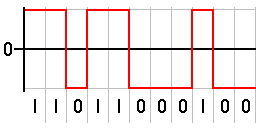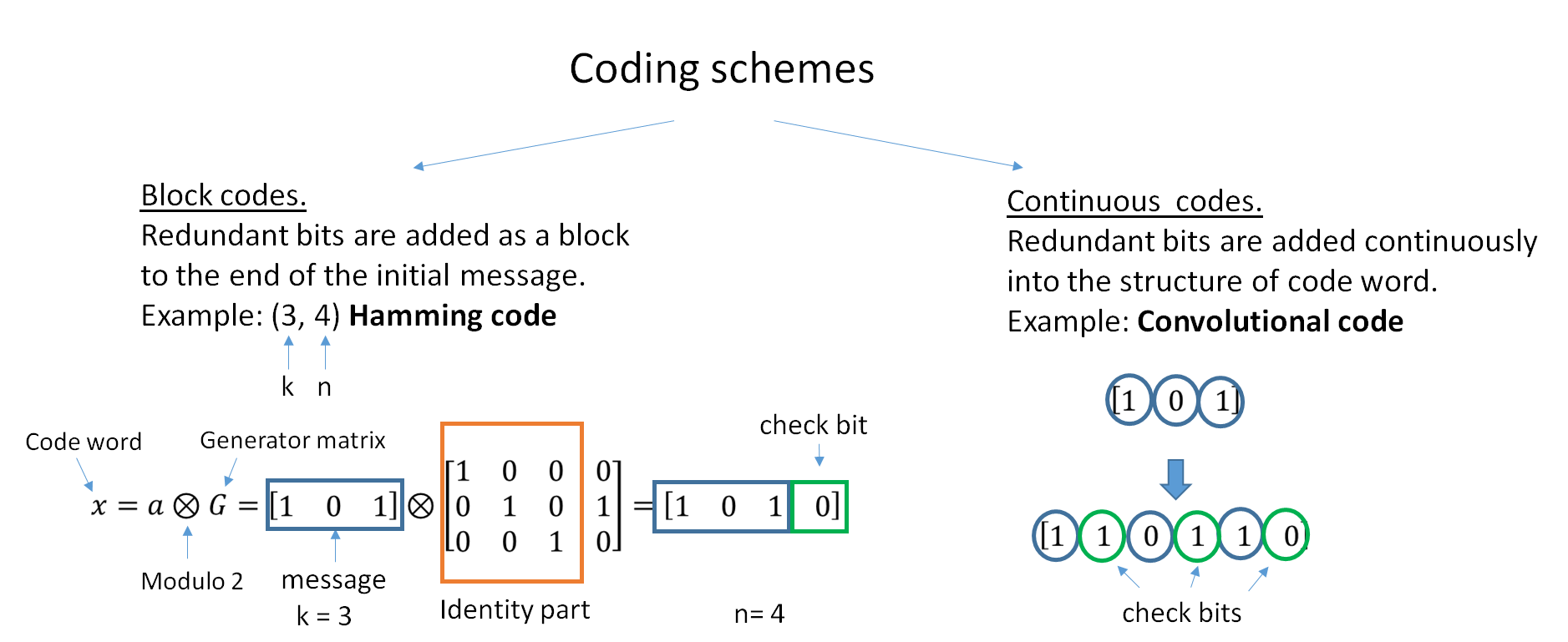|
Run Length Limited
Run-length limited or RLL coding is a line coding technique that is used to send arbitrary data over a communications channel with bandwidth limits. RLL codes are defined by four main parameters: ''m'', ''n'', ''d'', ''k''. The first two, ''m''/''n'', refer to the rate of the code, while the remaining two specify the minimal ''d'' and maximal ''k'' number of zeroes between consecutive ones. This is used in both telecommunication and storage systems that move a medium past a fixed recording head. Specifically, RLL bounds the length of stretches (runs) of repeated bits during which the signal does not change. If the runs are too long, clock recovery is difficult; if they are too short, the high frequencies might be attenuated by the communications channel. By modulating the data, RLL reduces the timing uncertainty in decoding the stored data, which would lead to the possible erroneous insertion or removal of bits when reading the data back. This mechanism ensures that the bound ... [...More Info...] [...Related Items...] OR: [Wikipedia] [Google] [Baidu] |
Line Code
In telecommunication, a line code is a pattern of voltage, current, or photons used to represent digital data transmitted down a communication channel or written to a storage medium. This repertoire of signals is usually called a constrained code in data storage systems. Some signals are more prone to error than others as the physics of the communication channel or storage medium constrains the repertoire of signals that can be used reliably. Common line encodings are unipolar, polar, bipolar, and Manchester code. Transmission and storage After line coding, the signal is put through a physical communication channel, either a transmission medium or data storage medium.Karl Paulsen"Coding for Magnetic Storage Mediums".2007. The most common physical channels are: * the line-coded signal can directly be put on a transmission line, in the form of variations of the voltage or current (often using differential signaling). * the line-coded signal (the ''baseband signal'') underg ... [...More Info...] [...Related Items...] OR: [Wikipedia] [Google] [Baidu] |
Error Correcting Codes
In computing, telecommunication, information theory, and coding theory, an error correction code, sometimes error correcting code, (ECC) is used for controlling errors in data over unreliable or noisy communication channels. The central idea is the sender encodes the message with redundant information in the form of an ECC. The redundancy allows the receiver to detect a limited number of errors that may occur anywhere in the message, and often to correct these errors without retransmission. The American mathematician Richard Hamming pioneered this field in the 1940s and invented the first error-correcting code in 1950: the Hamming (7,4) code. ECC contrasts with error detection in that errors that are encountered can be corrected, not simply detected. The advantage is that a system using ECC does not require a reverse channel to request retransmission of data when an error occurs. The downside is that there is a fixed overhead that is added to the message, thereby requiring a h ... [...More Info...] [...Related Items...] OR: [Wikipedia] [Google] [Baidu] |
Bit Slip
In digital transmission, bit slip is the loss or gain of a bit or bits, caused by clock drift – variations in the respective clock rates of the transmitting and receiving devices. One cause of bit slippage is overflow of a receive buffer that occurs when the transmitter's clock rate exceeds that of the receiver. This causes one or more bits to be dropped for lack of storage capacity. One way to maintain timing between transmitting and receiving devices is to employ an asynchronous protocol such as start-stop. Alternatively, bit slip can be prevented by using a self-clocking signal (such as a signal modulated using OQPSK) or using a line coding such as Manchester encoding. Another cause is "losing count", as on a hard drive: if a hard drive encounters a long string of 0s, without any 1s (or a string of 1s without 0s), it may lose track of the frame between fields, and suffer bit slip. When a pulse of N consecutive zero bits are sent, clock drift may cause the hardware to ... [...More Info...] [...Related Items...] OR: [Wikipedia] [Google] [Baidu] |
8b/10b Encoding
In telecommunications, 8b/10b is a line code that maps 8-bit words to 10-bit symbols to achieve DC balance and bounded disparity, and at the same time provide enough state changes to allow reasonable clock recovery. This means that the difference between the counts of ones and zeros in a string of ''at least'' 20 bits is no more than two, and that there are not more than five ones or zeros in a row. This helps to reduce the demand for the lower bandwidth limit of the channel necessary to transfer the signal. An 8b/10b code can be implemented in various ways, where the design may focus on specific parameters such as hardware requirements, DC-balance, etc. One implementation was designed by K. Odaka for the DAT digital audio recorder. Kees Schouhamer Immink designed an 8b/10b code for the DCC audio recorder. The IBM implementation was described in 1983 by Al Widmer and Peter Franaszek. IBM implementation As the scheme name suggests, eight bits of data are transmitted a ... [...More Info...] [...Related Items...] OR: [Wikipedia] [Google] [Baidu] |
RLL Example 10110010
RLL may refer to: * Run Length Limited, an encoding scheme for disk drives * Relay Ladder Logic, a programming language for industrial control * Radio Local Loop, same as Wireless Local Loop (WLL) * Rahal Letterman Lanigan Racing Rahal Letterman Lanigan Racing is an auto racing team that has participated in the WeatherTech SportsCar Championship and the IndyCar Series. Headquartered in Brownsburg, Indiana and Hilliard, Ohio, it is co-owned by 1986 Indianapolis 500 win ..., an auto racing team in the WeatherTech SportsCar Championship * ''right lower lobe'', see List of medical abbreviations: R {{disambiguation ... [...More Info...] [...Related Items...] OR: [Wikipedia] [Google] [Baidu] |
IrDA
The Infrared Data Association (IrDA) is an industry-driven interest group that was founded in 1994 by around 50 companies. IrDA provides specifications for a complete set of protocols for wireless infrared communications, and the name "IrDA" also refers to that set of protocols. The main reason for using the IrDA protocols had been wireless data transfer over the "last one meter" using point-and-shoot principles. Thus, it has been implemented in portable devices such as mobile telephones, laptops, cameras, printers, and medical devices. The main characteristics of this kind of wireless optical communication are physically secure data transfer, line-of-sight (LOS) and very low bit error rate (BER) that makes it very efficient. Specifications IrPHY The mandatory IrPHY (Infrared Physical Layer Specification) is the physical layer of the IrDA specifications. It comprises optical link definitions, modulation, coding, cyclic redundancy check (CRC) and the framer. Different data r ... [...More Info...] [...Related Items...] OR: [Wikipedia] [Google] [Baidu] |
Differential Manchester Encoding
Differential Manchester encoding (DM) is a line code in digital frequency modulation in which data and clock signals are combined to form a single two-level self- synchronizing data stream. In various specific applications, this method is also called by various other names, including biphase mark code (CC), F2F (frequency/double frequency), Aiken biphase, and conditioned diphase.US DoD: ''Design handbook for fiber optic communications systems, Military handbook.'' Dept. of Defense, 1985, p. 65. Definition Differential Manchester encoding is a differential encoding technology, using the presence or absence of transitions to indicate logical value. An improvement to Manchester coding which is a special case of binary phase-shift keying, it is not necessary to know the initial polarity of the transmitted message signal, because the information is not represented by the absolute voltage levels but by their transitions. Differential Manchester encoding has the following advantag ... [...More Info...] [...Related Items...] OR: [Wikipedia] [Google] [Baidu] |
Compact Disc
The compact disc (CD) is a Digital media, digital optical disc data storage format that was co-developed by Philips and Sony to store and play digital audio recordings. In August 1982, the first compact disc was manufactured. It was then released in October 1982 in Japan and branded as ''Compact Disc Digital Audio, Digital Audio Compact Disc''. The format was later adapted (as CD-ROM) for general-purpose data storage. Several other formats were further derived, including write-once audio and data storage (CD-R), rewritable media (CD-RW), Video CD (VCD), Super Video CD (SVCD), Photo CD, Picture CD, Compact Disc-Interactive (CD-i) and Enhanced Music CD. Standard CDs have a diameter of and are designed to hold up to 74 minutes of uncompressed stereo digital audio or about 650 mebibyte, MiB of data. Capacity is routinely extended to 80 minutes and 700 mebibyte, MiB by arranging data more closely on the same sized disc. The Mini CD has various diameters ranging from ; t ... [...More Info...] [...Related Items...] OR: [Wikipedia] [Google] [Baidu] |
Eight-to-fourteen Modulation
Eight-to-fourteen modulation (EFM) is a data encoding technique – formally, a ''line code'' – used by compact discs (CD), laserdiscs (LD) and pre-Hi-MD MiniDiscs. EFMPlus is a related code, used in DVDs and Super Audio CDs (SACDs). EFM and EFMPlus were both invented by Kees A. Schouhamer Immink. According to European Patent Office former President Benoît Battistelli, "Immink's invention of EFM made a decisive contribution to the digital revolution." Technological classification EFM belongs to the class of DC-free run-length limited (RLL) codes; these have the following two properties: * the spectrum ( power density function) of the encoded sequence vanishes at the low-frequency end, and * both the minimum and maximum number of consecutive bits of the same kind are within specified bounds. In optical recording systems, servo mechanisms accurately follow the track in three dimensions: radial, focus, and rotational speed. Everyday handling damage, such as dust, fingerpri ... [...More Info...] [...Related Items...] OR: [Wikipedia] [Google] [Baidu] |
IBM PC Compatible
IBM PC compatible computers are similar to the original IBM PC, XT, and AT, all from computer giant IBM, that are able to use the same software and expansion cards. Such computers were referred to as PC clones, IBM clones or IBM PC clones. The term "IBM PC compatible" is now a historical description only, since IBM no longer sells personal computers after it sold its personal computer division in 2005 to Chinese technology company Lenovo. The designation "PC", as used in much of personal computer history, has not meant "personal computer" generally, but rather an x86 computer capable of running the same software that a contemporary IBM PC could. The term was initially in contrast to the variety of home computer systems available in the early 1980s, such as the Apple II, TRS-80, and Commodore 64. Later, the term was primarily used in contrast to Apple's Macintosh computers. These "clones" duplicated almost all the significant features of the original IBM PC architectures. ... [...More Info...] [...Related Items...] OR: [Wikipedia] [Google] [Baidu] |




